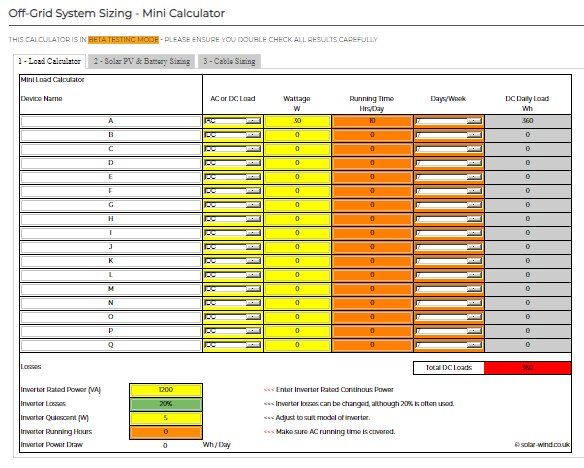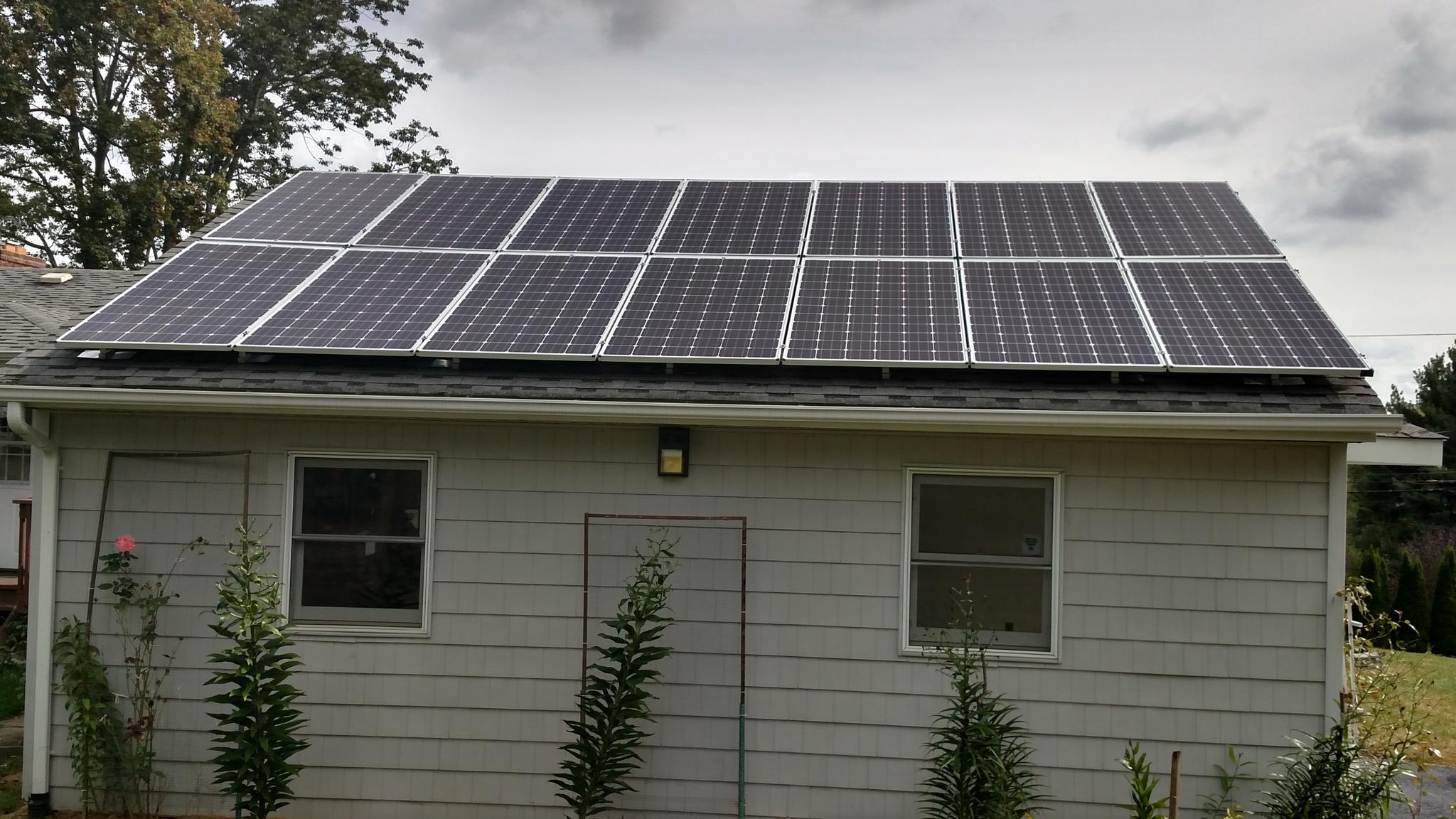- The solar electricity calculator considers an investment in a domestic solar PV system and estimates a) the average annual electricity bill savings, and b) the no. of years taken for these savings to accrue to the value of the initial investment (i.e. simple payback period)
- The simple payback calculation carried out in the calculator considers all costs as an initial investment outlay, a figure for which is entered by the user under question 5.
- In question 5 users are asked to enter the up-front capital cost only but there may be other costs associated with installing and operating a solar PV system which users may also wish to include in their response. For example, the costs of getting a Building Energy Rating, or any future repair and maintenance costs (including the cost of replacement components) are not requested here, but users may wish to ask their installer for an estimate of these figures so they can include them.
- The monetary savings come about as a result of homeowners reducing the amount of electricity they need to purchase from their electricity supplier. By buying less electricity from their supplier a monetary saving is made. Homeowners with solar PV systems will still pay the same amount on their electricity bill for standing charges and for the Public Service Obligation, but they will reduce the ‘unit usage’ (the amount of electricity consumed).
- Question 6 is used to estimate the proportion of the generated electricity that the homeowner can use themselves. In most cases homeowners will not be able to use 100% of the electricity they generate because it needs to be used at the point in time that it is generated and this is not always possible (for example if there is nobody in the home using electrical appliances at a particular time).
- If the user is not sure which response to select in any of the questions they can leave them unanswered and default responses will be used. These default responses use typical or average figures.
- All of the data and assumptions used in the calculator including the default responses can be examined by users by downloading the excel version of the tool. If you would like to provide feedback on any aspect of the calculator please send your comments to info@seai.ie
- The calculator assesses the savings and payback for a simple domestic solar PV system only – at present it is not configured to assess the impact of including storage technologies such as an immersion diverter or a battery. Factoring in the costs and savings arising from these additional technologies will change the savings and payback period.
NREL's PVWatts ® Calculator Estimates the energy production and cost of energy of grid-connected photovoltaic (PV) energy systems throughout the world. It allows homeowners, small building owners, installers and manufacturers to easily develop estimates of the performance of potential PV installations. The Solar Calculator allows you to also get a snapshot of your savings and returns if you opt in for Net Metering. The solar calculator is a work of more than 2000 man hours over a year put in by the engineering team at MYSUN. At the back end, the online calculator has mapped every possible location in India with consumer category-wise as well.
Reading Time: 4minutesPv Solar Calculator
The financial benefits of going solar are now well documented. Solar panel systems actually function as investments with strong rates of return, and homeowners generating solar electricity can avoid paying increased utility rates by eliminating their electricity bills. According to a 2015 report by the Lawrence Berkeley National Laboratory, installing solar panels on your home can even increase your property values. If you’re reviewing multiple quotes, there are plenty of metrics that can help you make a decision about which solar option is best for you, but studies show most solar shoppers rely on one metric in particular: the solar panel payback period or break-even point.

Solar payback periods summarized
- Your “solar payback period” is the time it takes to make back your initial investment in solar
- For most solar shoppers, you’ll break even in about 8 years
- Start comparing solar quotes on the EnergySage Marketplace for maximum savings

What is the average payback period for solar panels in the U.S.?
The solar panel payback period is a calculation that estimates how long it will take for you to “break even” on your solar energy investment. Increased utility electricity rates and lower equipment costs are making it easier and less expensive to for homeowners to own, rather than lease, their solar panel systems. Comparing the payback period of various quotes from solar installers is an easy way to comprehend the financial merits of each option, and identify the point in time at which your solar investment will start to earn you money.
The typical solar payback period in the U.S. is just above 8 years. If your cost of installing solar is $20,000 and your system is going to save you $2,500 a year on foregone energy bills, your solar panel payback or “break-even point” will be 8 years ($20,000/$2,500 = 8).
How is the solar panel payback period calculated?
To calculate your solar panel payback period, you need to determine the combined costs and annual benefits of going solar. To understand each component, review the following information:
Solar Pv Calculator Europe
- Gross cost of solar panel system: The gross cost of installing solar on your home is dependent on the size of the system you select and the equipment that makes up that system.
- Value of up-front financial incentives: Tax breaks and rebates can dramatically reduce the cost of going solar. The federal investment tax credit allows you to deduct 26% of the cost of your system from your taxes, and additional state and local financial incentives may also be available in your area.
- Average monthly electricity use: The amount of electricity that you consume monthly is an indicator of both the size of system you need and the amount of electricity that you can offset each month with solar. The higher your electricity bills are, the shorter your estimated payback period will be, as you can reduce or eliminate this bill as soon as your panels are operational.
- Estimated electricity generation: While solar installers will try to provide you with a system that matches your electricity consumption, practical constraints like the size of your roof and seasonal weather variation may impact the amount of electricity that you can produce on-site.
- Additional financial incentives: In some areas of the country, you may be able to earn additional incentives in the form of solar renewable energy certificates (SRECs) or other utility programs that give you a per kilowatt-hour credit for the electricity that your solar panels generate. Depending on the size of your solar energy system, these can represent a significant monetary benefit.
Take the following steps to calculate your payback period:
- Determine combined costs. Subtract the value of up-front incentives and rebates from the gross cost of your solar panel system.
- Determine annual benefits. Sum up your annual financial benefits, including avoided electricity costs and any additional incentives.
- Divide your combined costs by your annual financial benefits. The result will be the number of years it will take for you to achieve payback. Every month of savings after that point in time should be counted as a financial gain!
Three Tips for Solar Shoppers
1. Homeowners who get multiple quotes save 10% or more
As with any big ticket purchase, shopping for a solar panel installation takes a lot of research and consideration, including a thorough review of the companies in your area. A recent report by the U.S. Department of Energy’s National Renewable Energy Laboratory (NREL) recommended that consumers compare as many solar options as possible to avoid paying inflated prices offered by the large installers in the solar industry.
To find the smaller contractors that typically offer lower prices, you’ll need to use an installer network like EnergySage. You can receive free quotes from vetted installers local to you when you register your property on our Solar Marketplace – homeowners who get 3 or more quotes can expect to save $5,000 to $10,000 on their solar panel installation.
2. The biggest installers typically don’t offer the best price
The bigger isn’t always better mantra is one of the main reasons we strongly encourage homeowners to consider all of their solar options, not just the brands large enough to pay for the most advertising. A recent report by the U.S. government found that large installers are $2,000 to $5,000 more expensive than small solar companies. If you have offers from some of the big installers in solar, make sure you compare those bids with quotes from local installers to ensure you don’t overpay for solar.
3. Comparing all your equipment options is just as important
National-scale installers don’t just offer higher prices – they also tend to have fewer solar equipment options, which can have a significant impact on your system’s electricity production. By collecting a diverse array of solar bids, you can compare costs and savings based on the different equipment packages available to you.
There are multiple variables to consider when seeking out the best solar panels on the market. While certain panels will have higher efficiency ratings than others, investing in top-of-the-line solar equipment doesn’t always result in higher savings. The only way to find the “sweet spot” for your property is to evaluate quotes with varying equipment and financing offers.
For any homeowner in the early stage of shopping for solar that would just like a ballpark estimate for an installation, try our Solar Calculator that offers upfront cost and long-term savings estimates based on your location and roof type. For those looking to get quotes from local contractors today, check out our quote comparison platform.
Solar Pv Calculator Excel
This post originally appeared on Mother Earth News.